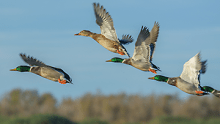NWDP: Avian Health in Wildlife

NWDP collects samples from wild birds for disease surveillance. Surveillance helps APHIS better understand and track the presence of avian influenza and other pathogens of concern along migratory bird pathways.
Detecting highly pathogenic avian influenza viruses in wild birds, or influenza viruses that have the potential to mutate to high pathogenicity, is the primary focus of wild bird surveillance efforts; however, the NWDP also checks for several other avian pathogens that could have a potential impact on domestic poultry, human health, and other wild bird species.
Since 2006, the NWDP and its collaborators have collected over 500,000 samples from wild birds by using a structured surveillance framework developed in cooperation with APHIS Veterinary Services and other members of the Interagency Avian Influenza Steering Committee. Many of these samples come from either live trapping wild birds, from collaborator work with bird banding operations, or from opportunistic collection from hunter harvest. The program can also test samples for other avian pathogens that have a potential impact on domestic poultry, human health, or other wild bird species, including avian paramyxovirus serotype-1, Salmonella, and a variety of arboviruses.
Avian Influenza
Avian influenza virus infections are common in wild birds around the world. In most cases, infected birds show little sign of disease; however, some strains can become highly pathogenic in domestic poultry and more recently, those highly pathogenic strains have been circulating persistently in wild birds. Highly pathogenic avian influenza is extremely contagious and deadly to domestic poultry. If found in the United States, the appropriate management action is to quickly eradicate the disease to protect poultry producers, flocks, and the economy. Wild bird surveillance helps APHIS to better understand and track the presence or introduction of avian influenza along migratory wild bird pathways. Advanced warnings from wild bird surveillance enable poultry producers to consider altering biosecurity in the face of increased AIV risk and also help inform zoonotic disease potential. For more information, visit Detections of Highly Pathogenic Avian Influenza in Wild Birds.
Avian Paramyxovirus Serotype-1
Newcastle disease is a contagious viral disease of birds and is caused by virulent avian paramyxovirus serotype 1. More than 230 bird species are susceptible to avian paramyxoviruses, but many infected birds do not show symptoms. In wild birds, the effects vary depending on the bird species and the severity of the APMV strain. Newcastle disease is usually suspected when large die-offs of cormorants, gulls, or pelicans are detected in the upper Midwest or northeast regions of the United States.
Severity of avian paramyxovirus serotype-1 is measured by its ability to cause disease in chickens and is subsequently categorized as a high or low pathogenic virus. Virulent Newcastle disease virus (vND) refers only to virus strains of high pathogenicity. The poultry industry is concerned with vND because it causes illness, death, and reduced egg production that can result in severe economic losses. While rare in the United States, vND has been introduced in the past by illegal trafficking of exotic birds.
Other Avian Health Diseases
Arboviruses are pathogens that can be transmitted by arthropods, like mosquitoes. Some of these viruses can cause severe disease in humans and can even result in death. Arboviruses that the NWDP has worked on in the past include Eastern equine encephalitis virus (EEEV), St. Louis encephalitis virus (SLEV), and LaCrosse virus (LACV).
Salmonella spp. are common bacteria causing infection in birds, other animals, and people. Salmonella spp. infection is a continuous problem for the poultry industry and leads to significant morbidity and mortality in domestic flocks. Eggs or meat contaminated with Salmonella spp. can cause disease outbreaks in people and represent a public health risk. Infection is common in wild birds, especially in areas where large numbers of birds gather.
Contact Us
National Wildlife Disease Program
The National Wildlife Disease Program works with partners nationwide to conduct disease monitoring and surveillance in wild animals and is the primary emergency response contact point within APHIS Wildlife Services. Our program coordinator is available for questions about wildlife disease monitoring and surveillance, the status of disease outbreaks and emerging disease events, and wildlife emergency response activities in natural disasters (floods, hurricanes, wildfires) or oil spills.
Julianna Lenoch
National Wildlife Disease Program Coordinator
Email: julianna.b.lenoch@usda.gov
Phone: 970-266-6350

